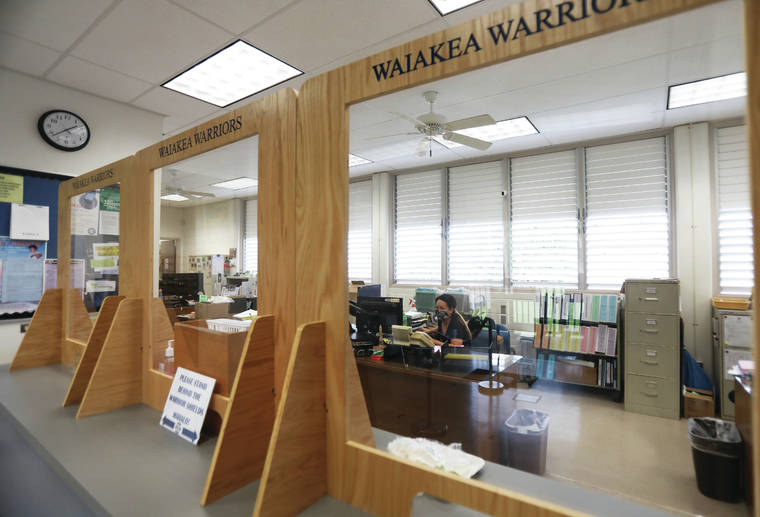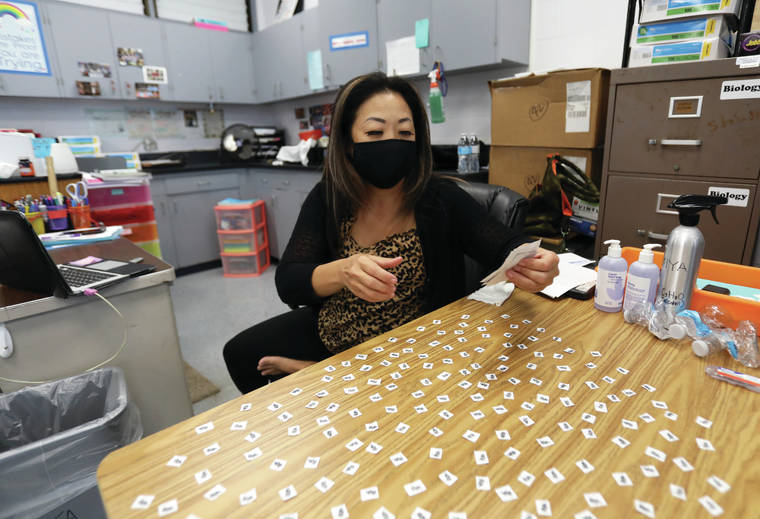State House committee discusses several COVID-related topics with DOE officials

Kelsey Walling/Tribune-Herald A front office employee works at her desk behind plexiglass at Waiakea High School in Hilo on Tuesday. The plexiglass and wooden frames were put together in Waiakea’s wood-shop class.

Kelsey Walling/Tribune-Herald Rochelle Tamiya prepares an activity for her biology class while teaching virtually at Waiakea High School in Hilo on Tuesday. Tamiya has become accustom to making sure there are class activities for students to do at their homes.
State Superintendent of Education Christina Kishimoto said as public schools hope to move to full in-person instruction at some point during the second semester this school year, more than 90% of the students in grades K-12 statewide are receiving at least a portion of their classes virtually.
State Superintendent of Education Christina Kishimoto said as public schools hope to move to full in-person instruction at some point during the second semester this school year, more than 90% of the students in grades K-12 statewide are receiving at least a portion of their classes virtually.
Kishimoto told the state House Committee on Lower and Higher Education on Tuesday that 42,751 students statewide are receiving all their instruction via distance learning, while 112,621 students are in a blended instruction model, with both in-person and online classes. That’s 90.4% of the students served by the state Department of Education.
Another 16,531 students, or 9.6%, are receiving all their instruction in-person. Those include special education and special needs students, as well as students with internet connectivity issues.
Rep. David Tarnas, a Democrat who represents North Kona and North and South Kohala, asked what the DOE is doing for rural districts such as his “so we can have more equitable access to internet services so the students can have a fair chance to learn.”
Kishimoto said she’s sitting on a couple of national educational committees to work on the problem of internet connectivity. She added that despite donated internet hot spots, the DOE needs “a lot of help” to provide wireless internet service that can provide rural students with enough bandwidth to deliver video classes at home.
Despite the COVID-19 pandemic, the DOE has the “lowest amount of teacher vacancies, ever, as well as special ed vacancies,” Kishimoto said. She also said requests by teachers for substitute teachers “are low this year, and thus, are very manageable,” calling the situation “a huge credit to our teaching workforce.”
In response to a question by Rep. Amy Perruso, an Oahu Democrat and former secretary-treasurer of the Hawaii State Teachers Association, Assistant Superintendent Cynthia Covell told lawmakers that the DOE said a $10,000 “differential” paid to special education teachers that started in January “had the desired effect” on recruitment.
“Normally, we run about 200 SPED teacher vacancies a year, filled with emergency hires and such,” Covell said. “Right now, we have 69 SPED teacher vacancies. So that is one of the lowest rates we’ve seen in quite a while.”
Committee Chairman Justin Woodson, a Maui Democrat, inquired about what Kishimoto described as a “hot topic”: COVID vaccinations in schools, once a vaccine becomes available.
Kishimoto replied that schools would need the help of the state Department of Health “to get education out there, to be clear about what the research and information is around those vaccines.”
“I would still absolutely honor parental choice around this,” she said.
Jeanne Kapela, a Democrat representative-elect whose district runs from Naalehu to Kailua-Kona, asked if the DOE will provide extra personnel to disinfect frequently touched surfaces at schools and personnel to run isolation areas for students experiencing COVID symptoms, or if schools will have to pay for those services out of their own budgets.
“About 93, 94% or our budget is in the hands of schools,” Kishimoto replied. “And so, what we are doing is providing guidance around and support around how to think about staffing, training the staff and making sure we hear from them what kind of training employee groups need to do this well.
“We also highly rely on part-time workers, so it’s really been about re-deploying and hiring part-time staff to do different work, these days.”
Rep. Troy Hashimoto, a Maui Democrat, asked what is being done to stockpile personal protective equipment and about federal coronavirus funding being used for that purpose.
Kishimoto replied that the DOE relies on the Hawaii Emergency Management Agency “for some of our supplies, and especially for bulk ordering and receiving those.”
“We’re really trying to figure out who’s paying for what, because the funding really went to HI-EMA for PPEs,” she said. “… HI-EMA was clear that they didn’t have enough for the entire year, right? … We have provided allocations to schools to help out, early on. And we have done direct order, via HI-EMA.”
Kishimoto added there is a school-by-school chart at each complex “where we monitor whether they have a two-month supply in the mandated areas.”
“No school is running out of funds,” she said. “We have only distributed the first half of the year’s funds, so they haven’t even tapped into the funds that we will release to them in January.”
Rep. Dale Kobayashi, an Oahu Democrat, said Hawaii is one of three states that hasn’t started interscholastic sports. Calling school sports “a part of the learning process,” he said it’s his understanding that school athletic directors have been resistant to starting sports seasons, and called it “somewhat troubling.”
“Do you have any plans at the DOE to set metrics for opening sports back up, or some of the easier sports to social distance?” Kobayashi asked.
“The DOE early on, along with all the county mayors, even before school started, had indicated that until we were further along with in-person learning, we would not start up sports,” Kishimoto replied. “So we did, very early on, indicate … in the order we would look at sports and we would look at even after-school programming and how we would stage this, again, prioritizing in-person learning, because of … how to bring kids on safely and so forth.”
Deputy Superintendent Phyllis Unebasami added the DOE has “a draft document around athletics” that has been shared with the Department of Health, and with charter and private schools, and a working group has been created to ascertain best practices in proceeding forward.
“Just know that it’s not at a standstill, that it is moving,” Unebasami said, and added once those practices are identified, they will be published.
Email John Burnett at jburnett@hawaiitribune-herald.com.


